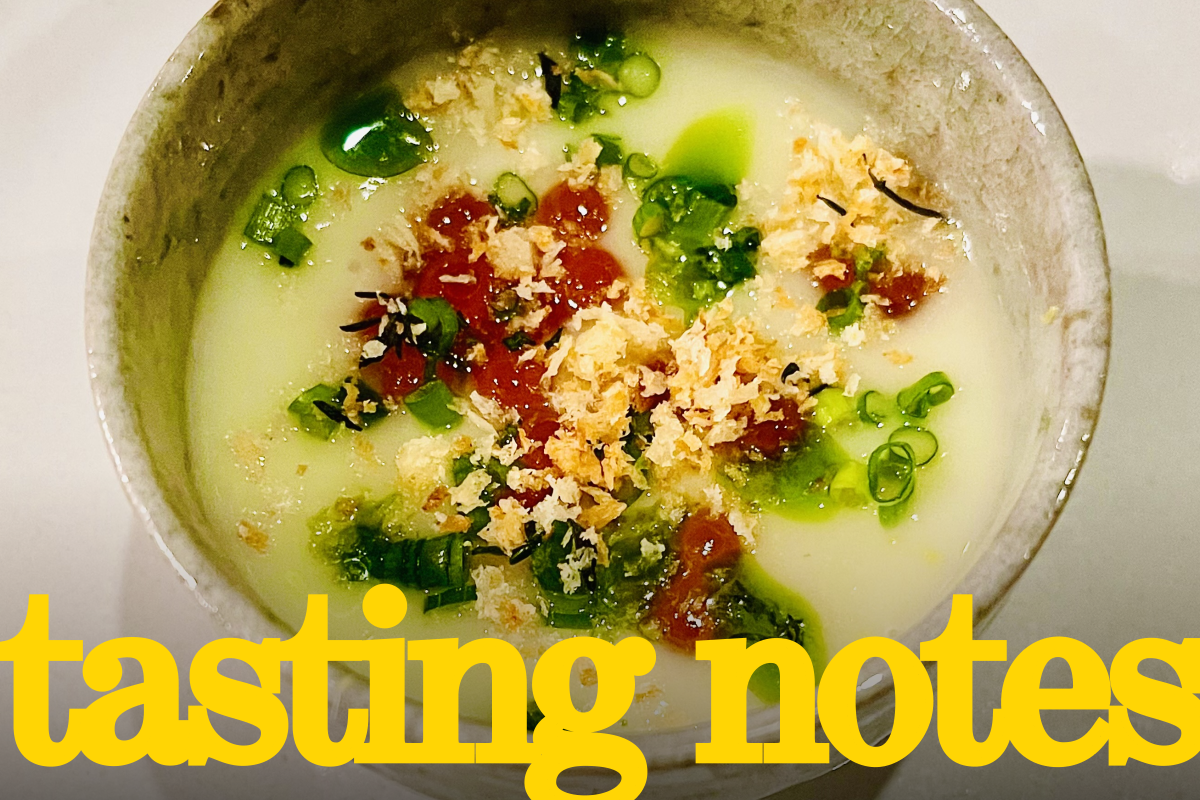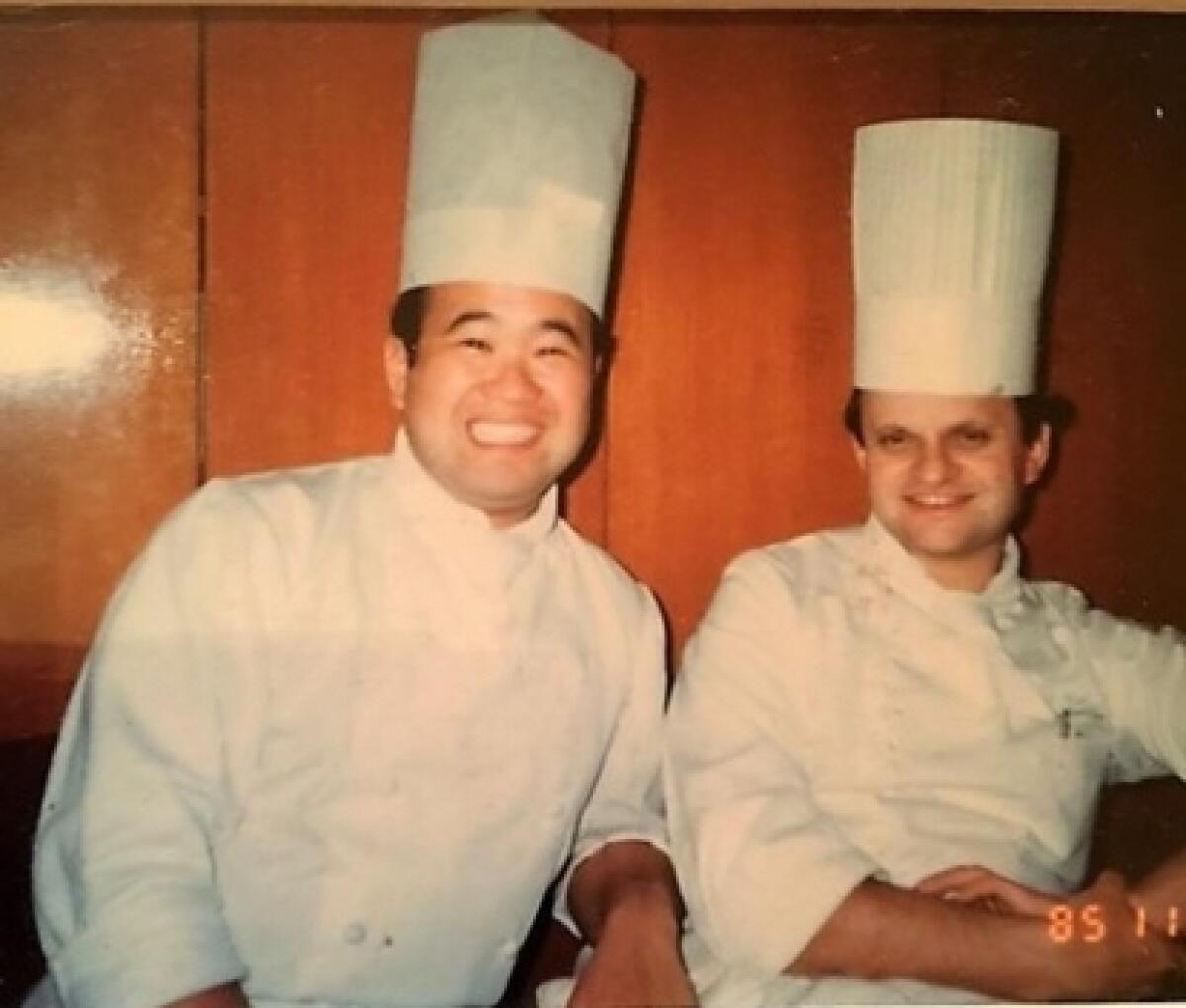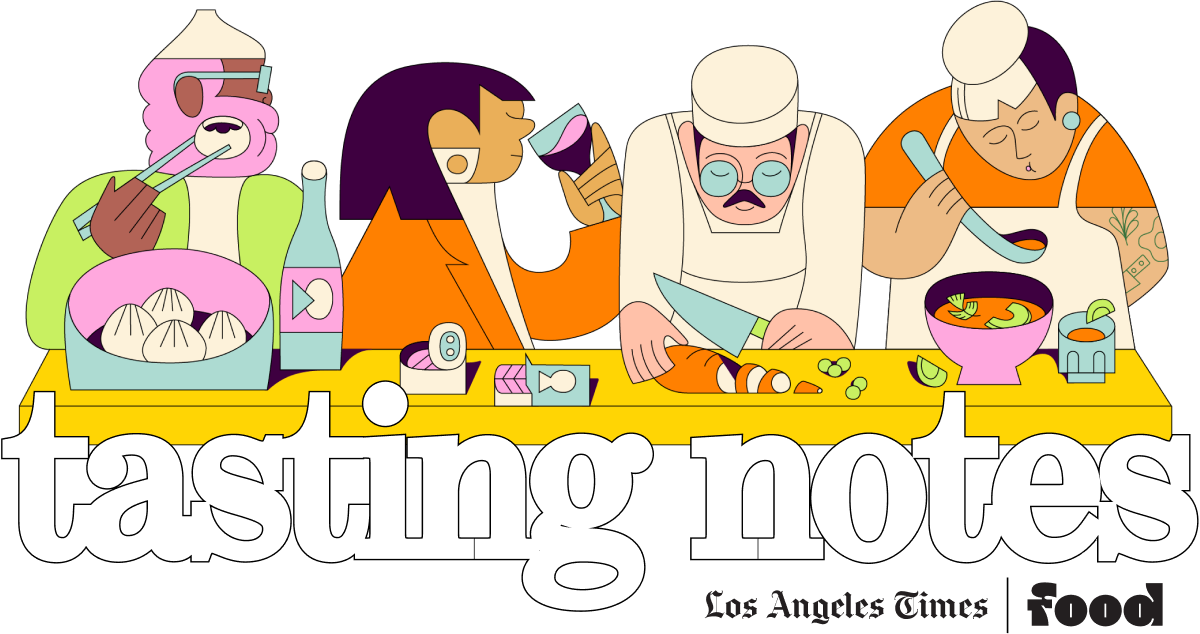The California chefs who pioneered L.A.’s French-Japanese aesthetic

Gustavo Arellano’s dispatch from “America’s unofficial Chile Highway.” Cooking for Día de Muertos. A giant corn maze. And big kids sucking on baby food-style pouches — will it change how they eat as adults? I’m Laurie Ochoa, general manager of L.A. Times Food, with this week’s Tasting Notes.
L.A.’s French-Japanese connection

Stories of the life and times and food of Akira Hirose, who died Sept. 26 at the age of 70, were flowing last Saturday night at the Little Tokyo restaurant Azay, which the chef opened in 2019 after many years running the Franco-Japanese Maison Akira in Pasadena and heading the Tower restaurant downtown and Belvedere at the Peninsula Beverly Hills.
At one large table sat members of Hirose’s family, including his brother, daughters and wife Jo Ann Hirose, who is familiar to many regular customers for her tips on what’s good when she takes their orders, as well as to many in the neighborhood who know her as their dental hygienist. The late chef’s son Philip Hirose, interviewed recently for Stephanie Breijo‘s wonderful article last week about the elder Hirose, was helping serve food and field memories from customers who wanted to share anecdotes about his father.

Many of the dishes on the three-course menu, with a few optional add-ons, were interpretations by chef Chris Ono of classic Hirose dishes, including a beautifully cooked Chilean sea bass with ratatouille, couscous and lemon beurre blanc.
But it was a surprise opening course — vichyssoise with a pop of dashi-cured ikura, chive oil and “herb popcorn” — that set off my own memory bank. A spoonful of the smooth, cool soup took me back not only to Hirose’s cooking but also to another chef’s soup that was my first encounter in the 1980s with the style of cooking that became known as Franco-Japanese cuisine and found an enthusiastic audience here in Los Angeles.
Masayuki Ishikawa was the chef, and the soup he served at his eccentric haute cuisine diner called Ishi’s Grill was a vivid green fresh pea emulsion with an undercurrent of mussels. I’ve never eaten another dish that recaptures the intense brightness of that soup. Ishikawa, who according to his Instagram posts, lives in Kyoto and gives cooking classes, private dinners and flea market advice (which makes sense since I was obsessed with his hutch of artfully mismatched dishes at Sawtelle Kitchen, the 1990s restaurant he opened after Ishi’s Grill) plus Hirose were just two of several pioneering Japanese chefs who fell in love with French food and brought their own style to one of the essential building blocks of California cuisine.
Susumu Fukui, chef of the original La Petite Chaya in Los Feliz, which begat several other Chayas, including Chaya Brasserie, was a major early influence. In her Substack newsletter La Briffe, former L.A. Times (and New York Times) restaurant critic Ruth Reichl reprinted an early La Petite Chaya menu that included “baked oyster with spicy sauce au gratin,” “a triple mousse treat: red bell pepper, fennel and artichoke” and “the Chaya specialty, our original fresh tuna sashimi salad.”
Hideo Yamashiro, who founded Shiro in South Pasadena and Orris on Sawtelle, worked with Wolfgang Puck at Ma Maison before charting his own course. In fact, Puck is the chef who also set off the California careers of Kazuto Matsusaka of Zenzero and the much-missed Beacon, plus Hiro Sone, who with his wife, Lissa Doumani, opened the Napa Valley restaurant Terra in 1988. Reichl also reprinted an early Terra menu, including a mention of the restaurant’s fricassée of sweetbreads, which makes me wish Sone and Doumani were still running Terra.
The idea of combining Japanese flavors and techniques with French cuisine is not new. The TV drama “La Grande Maison Tokyo” on Netflix — about a difficult and talented Japanese chef’s obsession with getting three Michelin stars — shows how deep the intertwining of the two cuisines goes. (It also has some of the best insights into how a chef comes up with new dishes.) At one point the chef expresses shock when another says he’s going to return to traditional Japanese cooking: “You’re not going to leave French cuisine!”
And of course, French cuisine as it developed in the nouvelle dishes of the 1970s and ‘80s, owes a debt to Japan.
“In the ‘70s, all the big French chefs — Michel Guerard, Paul Bocuse, [Alain] Senderens and [Jean and Pierre] Troisgros — were all going to Japan, and they brought back the idea of multicourse menus,” New York’s Daniel Boulud said in a 2007 L.A. Times interview. “So now, you have the menu degustation, which is in a way, a kaiseki menu.”
Yet in the 1980s and 1990s, California was one of the few places where there was an audience for Japanese chefs leading restaurants that served French cooking. Many places around the country just weren’t interested in Japanese cooking.
“There had been sushi restaurants in New York since the ‘50s, but there was a very limited audience,” Reichl told me recently. “When I got to the New York Times in the ‘90s I had to tell people how to eat sushi.”
More compelling than looking back, however, is looking forward to what is to come. Earlier this year, Tsubaki’s Charles Namba and Courtney Kaplan opened the French Japanese bistro Camélia in the Arts District with a menu that isn’t simply French with Japanese influences but seems to give each cuisine equal time. And in Breijo’s most recent column on restaurant openings (including the new Olive & Rose from Philip and Lauren Pretty, who run the one-Michelin-star restaurant Heritage in Long Beach, plus Chez Mia, Sogno Toscano and A Tí in Echo Park), she reports that Gjusta and Gjelina former chef Travis Lett has opened “a Japan-meets-California izakaya” called RVR (pronounced “River”).
Plus, I can’t wait to find out how Azay develops over time with Ono, who was so impressive at the tasting-menu pop-up Hansei inside Little Tokyo’s Japanese American Cultural and Community Center. With so much of Little Tokyo in flux, it’s reassuring that Hirose’s family and Ono want to continue the legacy of an L.A. pioneer.
Setting the memory table

Paola Briseño-Gonzalez wrote a beautiful Día de Muertos story, our cover feature for Sunday’s Weekend section, about the transition she’s witnessed with the holiday — from a simple ritual of scrubbing loved ones’ graves and adorning them with flowers and favorite foods to an established Angeleno tradition and full-on tourist and cultural phenomenon seen not only in movies like “Coco” but in James Bond action sequences. She also shares useful information for those who want to build their own altars and a companion story on foods to make for Día de Muertos, with recipes for mixiotes de pollo or parchment-wrapped chicken and capirotada tropical (bread pudding with guava and apricots).
When big kids suck on baby food pouches

“They have such a choke hold on my family. I can’t imagine our grocery list without it at this point,” says Caitlin Scuttio, who spends $200 on packaged pureed food for her family. “We are definitely a pouch family.” Reporter Jenny Gold examines the growing market for food pouches, which have increased 900% in sales since 2010, and may have long-standing effects on nutrition and the food preferences of our next generation of kids. One pediatric gastroenterologist told Gold that “he sometimes sees children who are so reliant on the smooth, sweet taste of pouches that they have developed food and texture aversions and refuse to eat regular fruits or vegetables.”
You’re reading Tasting Notes
Our L.A. Times restaurant experts share insights and off-the-cuff takes on where they’re eating right now.
You may occasionally receive promotional content from the Los Angeles Times.
Also ...
- Deputy food editor Betty Hallock talked with heirloom bean king Steve Sando about his new “The Bean Book: 100 Recipes for Cooking With All Kinds of Beans, From the Rancho Gordo Kitchen,” written with Julia Newberry. After cooking with the book, Hallock says, “Do yourself a favor and cook a pot of beans, any beans, on a Sunday.” It doesn’t have to be difficult, Sando says: “My best dish is a bowl of beans, chopped onions, squeeze of lime, done. I used to add cheese or heavy cream, but now I think, ‘How much can you take away and still have it be fabulous?’”
- Assistant food editor Danielle Dorsey put together a guide to 14 of the most creative and unique tacos to try from this summer’s special on the 101 Best Tacos in Los Angeles.
- Reporter Jessica Garrison goes “deep inside one of the world’s largest corn mazes, where the tri-tip sandwiches and soft-serve ice cream purchased at the concession stand have become but a memory and all that can be seen in any direction are dirt paths and dead-end walls of green plants whispering in the breeze, people tend to reveal themselves.” She’s talking about the Solano County Cool Patch Pumpkins corn maze from second-generation California farmer Matt Cooley designed by his daughter-in-law Tayler Cooley. Previous Cooley family mazes have twice earned a Guinness World Record as the world’s largest corn maze. Garrison also explores how these giant mazes serve “as a towering 60-acre experiment in human psychology.”
- Business writer Andrea Chang reports on the listeria recall that has expanded to 12 million pounds of meat and poultry sold at Trader Joe’s, Target and other retailers.
- Columnist Gustavo Arellano‘s Caminos del Southwest series, a seven-state tour talking to Latinos about the election, includes a dispatch from “America’s unofficial Chile Highway” since “agriculture is an underrated barometer of where a region and its people are heading, since it intersects with so many essential issues: the economy, climate change, immigration.” He also stops in for tacos and political temperature taking at San Bernardino’s Mitla Cafe, the Cal-Mex restaurant that inspired the founding of Taco Bell. “I’m afraid to talk politics” publicly, Mitla co-owner Steven Oquendo told Arellano. “Because it’s so divisive now that it’s unbelievable.”
- And finally ... early bird tickets are already sold out for this year’s L.A. Times 101 Best Restaurants Reveal Party presented by City National Bank. But regular-priced tickets are now on sale, including VIP tickets that get you into the tasting 45 minutes before general admission ticket holders. Last year, those tickets went fast.
Eat your way across L.A.
Like what you're reading? Sign up to get it in your inbox every week.
You may occasionally receive promotional content from the Los Angeles Times.

Eat your way across L.A.
Get our weekly Tasting Notes newsletter for reviews, news and more.
You may occasionally receive promotional content from the Los Angeles Times.




